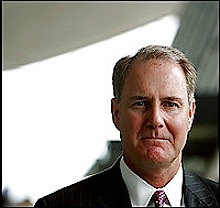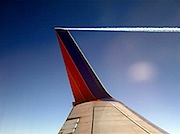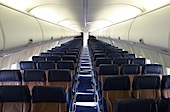Yours truly is in the midst of my usual two week holiday hiatus from publishing PlaneBusiness Banter this week — and in fact I’m not at either the main Worldwide Headquarters in the swamp or at the branch office in Dallas.
Today I find myself in the lovely confines of Tucson, Arizona. The sun is out — but it was a bit chilly here this morning. 33 degrees to be exact. Yes, we are on the back end of the same storm that dumped the almost four inches of snow on Las Vegas this week. The same storm that is now making life in much of the rest of the country more than miserable.
My condolences to those of you trying to fly out or into Chicago today — but for those of you on the East Coast — it’s coming your way later today. Oh, boy. Just what our friends, the things with wings, need to contend with on the weekend before Christmas.
But enough of my frigid travel travails. Let’s talk about some news of note involving the things with wings. Southwest Airlines to be precise.
Chief Executive Magazine Cites Southwest’s CEO for “Wealth Destruction”

Chief Executive magazine used its end-of-year issue to note those CEOs who they think are both doing the best and worst jobs at creating value at their respective companies.
In its first annual Chief Executive/Applied Finance Group Wealth Creation Rankings — the magazine partnered with Applied Finance Group — creators of the Economic Margin (EM) value metric and Drew Morris, CEO of Great Numbers!
As the magazine noted in its introduction to its rankings,
“As we have seen with the recent meltdown in financial markets, value isn’t always what it appears to be. And traditional accounting measures do not count what really counts. Earnings per share (EPS) and price/earnings (P/E) ratios are based on accounting profit, which is prone to distortion and has no real relationship to wealth creation. Trying to grow earnings or EPS in the belief that the stock market will reward you with a higher share price no longer works, as investors really seek to understand the company’s underlying economic performance.
To state the obvious, navigating with instruments that mislead is dangerous. CEOs need to look at their businesses with the same wealth-creation measures that, for example, private equity and institutional investors use. Investors want to know how good a company and its leaders are at preserving and growing their capital.
Many companies have moved from accounting to economic approaches to measuring this. A few, such as EVA, are good because they reckon with the true cost of capital, but none are perfect. Our rankings rely on Economic Margin, a measure with which executives can readily manage wealth creation, and which is applicable at all levels of a company. EM is calculated as the difference between operating cash flow and an appropriate capital charge, all divided by invested capital. EM is suitable for both private and public companies and useful for making comparisons with competitors, as it’s an economic-profitability percentage, not a monetary amount.
The ranking method we used also considers management’s demonstrated ability to protect shareholder wealth and create truly valuable assets. Our intent is to advance the art, science and practice of creating wealth for a company’s owners and the associated results creation skills of its executive team.”
So who were the top ten best “wealth creators” according to this methodology?
|
10 Best Wealth Creators
|
|
CEO
|
COMPANY
|
|
1. J. Christopher Donahue
|
Federated Investors
|
|
2. Jeffrey P. Bezos
|
Amazon.com
|
|
3. Robert W. Selander
|
Mastercard
|
|
4. Mark Donegan
|
Precision Castparts
|
|
5. Hugh Grant
|
Monsanto
|
|
6. John W. Rowe
|
Exelon
|
|
7. John C. Martin, Ph.D.
|
Gilead Sciences
|
|
8. Daniel P. Amos
|
AFLAC
|
|
9. Andrea Jung
|
Avon
|
|
10. Clayton M. Jones
|
Rockwell Collins
|
And which CEOs were the best “wealth destroyers?”
|
10 Best Wealth Destroyers
|
|
CEO
|
COMPANY
|
|
1. James R. Tobin
|
Boston Scientific
|
|
2. Robert J. Coury
|
Mylan
|
|
3. Gary C. Kelly
|
Southwest Airlines
|
|
4. Herb M. Allison, Jr.
|
Fannie Mae
|
|
5. Eli Harari, Ph.D.
|
Sandisk
|
|
6. Glen F. Post, III
|
Centurytel
|
|
7. Larry L. Weyers
|
Integrys Energy
|
|
8. Steven R. Appleton
|
Micron Technology
|
|
9. John A. Luke, Jr.
|
Meadwestvaco
|
|
10. Lynn Laverty Elsenhans
|
Sunoco
|
Clearly, for our purposes here in PlaneBuzz, the only CEO of interest to us in all of this was Southwest’s Gary Kelly. Particularly because when Kelly was named as CEO of the airline, the bulk of the scuttlebutt around the announcement dealt with the fact that because he had been such an excellent CFO of the airline — that he would help shore up the airline’s financial side — and most importantly to stockholders — its stock price.
According to Chief Executive’s metric, however, Gary hasn’t fared too well over the last three years. Here is what the magazine said about Southwest.
“Gary Kelly, Southwest Airlines
Score: 6
Southwest’s low score may come as a surprise considering it’s arguably among the best-managed airlines. But it’s an airline; the only one in the S&P 500. That means planes, airport fees and lots of competition. The market is far from wild about the value of its assets. In the EM sector rankings, Southwest was grouped with other transportation companies, all of which performed better. Southwest’s EM ranged between -.5 percent (-.005) and -0.9 percent (almost -1 percent) over the 2005-07 period. While its SEC filings show a profit during this time, when Southwest’s off-balance sheet leases and other adjustments are accounted for, the picture reverses. For example, applying those adjustments to Southwest’s 2007 results increases its invested capital by $5.9 billion, or 35 percent. The $1.7 billion capital charge on this amount exceeded its $1.5 billion operating cash flow, resulting in a negative Economic Margin.”
The article is a very interesting read. Well worth it. And not just for its rather low opinion of Mr. Kelly’s ability to create and/or protect shareholder wealth at Southwest Airlines. You can access the entire article here.



